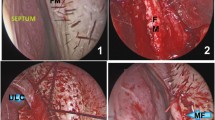Abstract
The surgical correction of nasal obstruction is definitely effective and recommended in patients with poor CPAP compliance, often secondary to the high pressures that need to be given in patients with nasal sub stenosis. For this reason, the objective of this study is the evaluation of the effectiveness and effects of the functional nose surgery on adherence to CPAP- therapy in patients (with moderate to severe OSAS with indication of ventilation therapy) poorly compliant with CPAP. The study was performed on a sample of 52 patients, 40 male and 12 female, aged between 29 and 72 years followed by the Otolaryngology Unit of the University Palermo in the period between January 2015 and January 2017. All patients were subjected to the following s iter: anamnesis with Epworth Sleepiness Scale, NOSE scale, evaluation of “CPAP usage data.” Upper airway optical fiber endoscopy with Müller’s maneuver. We performed various type of nasal surgery (septoplasty, decongestion of the lower turbinates and FESS) 6 months after the surgery, CPAP usage was evaluated and the NOSE scale has been reapplied. All patients had a subjective degree of obstruction classified in severe or extreme by the NOSE scale before surgery. Almost all patients reported a mild degree of obstruction after the surgery. About CPAP usage, the average usage has passed by 2, 3 h at night to 6, 8 h after the surgery. The result is significant because it shows how the nasal functional surgery can make selected patients suitable to ventilation therapy. As our work shows, a better nasal function allows to reduce the CPAP pressure, Therefore, we believe that all patients with medium to severe obstructive apnea syndrome and for whom night-time ventilation therapy (CPAP) is advised should be evaluated with endoscopy and anamnesis oriented to evaluate nasal obstructive pathologies that may reduce effectiveness of CPAP.

Similar content being viewed by others
References
Friedman M, Maley A, Kelley K et al (2011) Impact of nasal obstruction on obstructive sleep apnea. Otolaryngol Head Neck Surg 144(6):1000–1004
Leitzen KP, Brietzke SE, Lindsay RW (2014) Correlation between nasal anatomy and objective obstructive sleep apnea severity. Otolaryngol Head Neck Surg 150:325–331
Udaka T, Suzuki H, Fujimura T et al (2007) Relationships between nasal obstruction, observed apnea, and daytime sleepiness. Otolaryngol Head Neck Surg 137:669–673
Stapleton AL, Chang Y, Soose RJ, Gillman GS (2014) The impact of nasal surgery on sleep quality: a prospective outcomes study. Otolaryngol Head Neck Surg 151:868–873
Verse T, Maurer JT, Pirsig W (2002) Effect of Nasal Surgery on Sleep-Related Breathing Disorders. The Laryngoscope 112:64–68
Wu J, Zhao G, Li Y et al (2017) Apnea-hypopnea index decreased significantly after nasal surgery for obstructive sleep apnea: a meta-analysis. Medicine (Baltimore) 96(5):e6008
Marchese D, Modica DM, Cancemi S, Speciale S, Gallina S (2017) Anterior palatoplasty: effectiveness for treatment of simple snoring and mild osas. Euromediterr Biomed J12:57–60
Lorusso F, Dispenza F, Saraniti C, Sireci F, Modica DM, Gallina S (2014) Sleep disordered breathing: evaluation of dynamic patterns of the upper airways in obese subjects. Otorinolaringologia 64:57–64
Wu J, Zang H, Wang T, Zhou B, Ye J, Li Y, Han D (2017) Evaluation of the subjective efficacy of nasal surgery. J Laryngol Otol 131(1):37–43
Series F, St Pierre S, Carrier G (1992) Effects of surgical correction of nasal obstruction in the treatment of obstructive sleep apnea. Am Rev Respir Dis 146(5 Pt 1):1261–1265
Poirier J, George C, Rotenberg B (2014) The effect of nasal surgery on nasal continuous positive airway pressure compliance. The Laryngoscope 124:317–319
Ayers CM, Lohia S, Nguyen SA, Gillespie MB (2016) The Effect of upper airway surgery on continuous positive airway pressure levels and adherence: a systematic review and meta-analysis. ORL J Otorhinolaryngol Relat Spec 78(3):119–25. https://doi.org/10.1159/000442023
Hisamatsu K, Kudo I, Makiyama K (2015) The effect of compound nasal surgery on obstructive sleep apnea syndrome. Am J Rhinol Allergy 29:e192–e196
Camacho M, Riaz M, Capasso R et al (2015) The effect of nasal surgery on continuous positive airway pressure device useand therapeutic treatment pressures: a systematic review and meta-analysis. Sleep 38:279–286
Powell NB, Riley RW, Guilleminault C, Murcia GN (1988) Obstructive sleep apnea, continuous positive airway pressure, and surgery. Otolaryngol Head Neck Surg 99(4):362–369
Schwab RJ et al (2013) An official American Thoracic Society Statement: continuous positive airway pressure adherence tracking systems. The optimal monitoring strategies and outcome measures in adults. Am J Respir Crit Care Med 188(5):613–620
Li HY, Wang PC, Chen YP et al (2011) Critical appraisal and meta-analysis of nasal surgery for obstructive sleep apnea. Am J Rhinol Allergy 25:45–49
Xiao Y, Han D, Zang H et al (2016) The effectiveness of nasal surgery on psychological symptoms in patients with obstructive sleep apnea and nasal obstruction. Acta Otolaryngol 136:626–632
Shuaib SW, Undavia S, Lin J et al (2015) Can functional septorhinoplasty independently treat obstructive sleep apnea? Plastic Reconstr Surg 135:1554–1565
Yalamanchali S, Cipta S, Waxman J et al (2014) Effects of endoscopic sinus surgery and nasal surgery in patients with obstructive sleep apnea. Otolaryngol Head Neck Surg 151:171–175
Author information
Authors and Affiliations
Corresponding author
Ethics declarations
Conflict of interest
The authors have no conflicts of interest to disclose.
Ethical approval
This study was approved by Ethics Committee of University Hospital of Palermo.
Informed consent
Our research involved human participants who had obtained informed consent.
Rights and permissions
About this article
Cite this article
Modica, D.M., Marchese, D., Lorusso, F. et al. Functional Nasal Surgery and Use of CPAP in OSAS Patients: Our Experience. Indian J Otolaryngol Head Neck Surg 70, 559–565 (2018). https://doi.org/10.1007/s12070-018-1396-2
Received:
Accepted:
Published:
Issue Date:
DOI: https://doi.org/10.1007/s12070-018-1396-2



